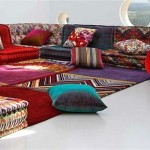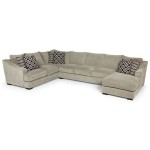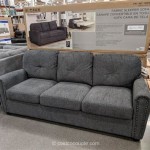Is A Dark Sofa A Good Idea? Exploring the Pros and Cons
The selection of a sofa represents a significant decision in interior design. It often serves as a focal point within a living space, influencing the overall aesthetic and contributing substantially to the room's comfort and functionality. Among the myriad of options available, dark sofas, encompassing colors such as charcoal gray, navy blue, deep brown, and black, possess a certain allure. However, determining whether a dark sofa is a suitable choice requires careful consideration of several factors, including the room's lighting, size, existing décor, and lifestyle of the occupants.
Dark sofas offer several advantages that make them appealing to many homeowners. They are often perceived as sophisticated and elegant, capable of adding a touch of drama and luxury to a room. Furthermore, dark colors are generally more forgiving when it comes to stains and dirt, which can be particularly beneficial in households with children or pets. The versatility of dark sofas also allows them to be incorporated into a variety of design styles, from modern minimalist to traditional and eclectic.
Conversely, dark sofas also present potential drawbacks. They can make a small room feel even smaller and more confined, particularly if the lighting is inadequate. Dark colors absorb light, which can create a somber and unwelcoming atmosphere if not properly balanced with lighter elements. Furthermore, dark sofas may not be the best choice for individuals who prefer a bright and airy aesthetic. Assessing these pros and cons in relation to the specific characteristics of the space and the desired ambiance is crucial for making an informed decision.
The Aesthetic Impact of a Dark Sofa
The aesthetic impact of a dark sofa is considerable, and its perceived effect within a room is multifaceted. The color of the sofa significantly influences the overall mood and atmosphere of the space. Dark colors typically evoke feelings of sophistication, elegance, and even mystery. A dark sofa can serve as a grounding element, providing a sense of stability and permanence within the room. In larger rooms, a dark sofa can help to visually anchor the space and prevent it from feeling too airy or disjointed.
However, the potential downsides should also be recognized. Dark colors absorb light, and a dark sofa can contribute to a sense of heaviness or gloominess, especially in rooms with limited natural light. It is essential to counteract this effect by incorporating lighter elements into the design. Light-colored walls, rugs, and accessories can help to reflect light and create a more balanced and inviting atmosphere. Strategic placement of lamps and other light sources can also help to brighten the room and prevent the dark sofa from dominating the space.
The style of the sofa also plays a crucial role in determining its aesthetic impact. A sleek, modern dark sofa with clean lines can create a minimalist and sophisticated look. Conversely, a plush, tufted dark sofa can evoke a more traditional and luxurious feel. The choice of fabric also contributes to the overall aesthetic. Velvet, for example, can add a touch of opulence, while leather can create a more rugged and masculine appearance. Considering the desired aesthetic and selecting a sofa that complements the existing décor is essential for achieving a cohesive and visually appealing design.
Practical Considerations: Durability and Maintenance
Beyond aesthetics, the practical aspects of owning a dark sofa are paramount, particularly in relation to durability and maintenance. Darker colors are generally more forgiving when it comes to stains and dirt, which can be a significant advantage in high-traffic areas or households with children and pets. While lighter-colored sofas may readily show spills and smudges, dark sofas tend to conceal minor imperfections, reducing the frequency of cleaning and maintenance.
However, it is important to note that dark sofas are not entirely immune to wear and tear. Over time, dark fabrics can fade or show signs of abrasion, particularly in areas that receive frequent use. Regular cleaning and maintenance are still necessary to preserve the sofa's appearance and extend its lifespan. Vacuuming regularly can help to remove dust and debris, while spot cleaning can address spills and stains promptly. Professional cleaning may be required periodically to deep clean the fabric and remove accumulated dirt and grime.
The choice of fabric also plays a crucial role in determining the sofa's durability and ease of maintenance. Leather, for example, is known for its durability and resistance to stains, although it may require occasional conditioning to prevent cracking. Microfiber is another popular choice for its stain resistance and ease of cleaning. Natural fabrics such as cotton and linen are comfortable and breathable but may be more prone to staining and require more frequent cleaning. Selecting a fabric that suits the lifestyle and maintenance preferences of the occupants is essential for ensuring the sofa's longevity and appearance.
Lighting and Room Size: Key Factors to Consider
The interplay between lighting and room size is critical to assess when considering a dark sofa. Dark colors absorb light, and a dark sofa can exacerbate the effects of poor lighting, making a room feel smaller and more enclosed. In small rooms or rooms with limited natural light, a dark sofa can create a sense of claustrophobia and make the space feel less inviting. Conversely, in large, well-lit rooms, a dark sofa can serve as a grounding element, adding depth and visual interest to the space without overwhelming it.
To mitigate the potential drawbacks of a dark sofa in a small or poorly lit room, it is essential to maximize the available light. Light-colored walls, floors, and ceilings can help to reflect light and create a brighter, more airy atmosphere. Strategic placement of mirrors can also help to amplify the light and make the room feel larger. Additionally, incorporating multiple light sources, such as lamps, overhead fixtures, and sconces, can help to illuminate the space and prevent the dark sofa from dominating the room.
The size of the room also influences the choice of sofa style and size. In small rooms, a compact sofa with clean lines is generally a better choice than a large, bulky sofa. A light-colored rug and accessories can also help to visually expand the space. In larger rooms, a larger sofa or sectional can be used to create a more comfortable and inviting seating area. A dark sofa can serve as a focal point in a large room, adding a touch of drama and sophistication. However, it is essential to balance the dark sofa with lighter elements to prevent the room from feeling too heavy or somber.
Ultimately, the decision of whether to incorporate a dark sofa into a living space is a complex one, requiring a careful evaluation of various factors. By considering the aesthetic impact, practical considerations, and the interplay between lighting and room size, homeowners can make an informed decision that aligns with their individual preferences and the specific characteristics of their space.

How To Style A Black Sofa Castlery Us

Ask Maria Should I Buy A Black Sofa Colour Expert

Small Cozy Living Room With Black Sofa Blushing Bungalow So Cute You Ll Blush
:max_bytes(150000):strip_icc()/thespruce-blacksofa-brophyinteriors-626b147410c048019db949219100067c.png?strip=all)
41 Living Room Ideas With Black Couches From Neutral To Bold
:max_bytes(150000):strip_icc()/thespruce-adrianorightsectional-shadesoflight-a7d89e3aebd741f9813d9bdf67d92f41.jpeg?strip=all)
41 Living Room Ideas With Black Couches From Neutral To Bold

Small Cozy Living Room With Black Sofa Blushing Bungalow So Cute You Ll Blush

Ask Maria Should I Buy A Black Sofa Colour Expert

What Colours Go With A Black Sofa Furniture Choice

Black Couch Living Room Ideas 10 Striking Seating
:max_bytes(150000):strip_icc()/thespruce-blacksofa-laquitatate3-a0320ec4abcc45d3b7cae988d8f8f2b0.png?strip=all)
41 Living Room Ideas With Black Couches From Neutral To Bold








